SP AF 300mm F/2.8 LD [IF] for Canon (Model 360EE) - Tamron
SP AF 300mm F/2.8 LD [IF] for Canon (Model 360EE) - Tamron
SP AF 300mm F/2.8 LD [IF] for Canon (Model 360EE) - Tamron
Create successful ePaper yourself
Turn your PDF publications into a flip-book with our unique Google optimized e-Paper software.
FILTERS<br />
(con’t)<br />
Setting and Removing Rear Filter into/from the Filter Frame<br />
The filter setting screw portion of the filter frame can be rotated. There<strong>for</strong>e, when removing<br />
or setting a filter, hold the filter rotating dial or the gear at the outer side of the filter setting<br />
screw with a finger so that it does not turn inadvertently.<br />
DEPTH-OF-FIE<strong>LD</strong><br />
The lens is marked with depth-of-field scales <strong>for</strong> apertures F16 and F32. Use these scales<br />
to check the approximate depth-of-field. Please refer to the separate table <strong>for</strong> exact depthof-field<br />
at different apertures and shooting distances.<br />
INFRARED INDEX<br />
A red filter is used when taking pictures with black and white infrared film. Due to<br />
characteristics of this combination, it is necessary to compensate the focus. The red scale<br />
marked "R" on the focus distance scale is the infrared index. Focus manually at first, read<br />
the scale at that position, and shift to the infrared index. Then, install a red filter and take<br />
pictures. When compensating the focus, switch to the manual focus mode, and rotate the<br />
focusing ring manually.<br />
When precise focusing is necessary, first take a test role of film. Also, please refer to the<br />
instruction sheet of the infrared film.<br />
PRECAUTIONS IN SHOOTING<br />
When the built-in flash of your camera is used, the lens may obstruct the light path of<br />
your flash, resulting in vignetting at the bottom of the image. Please also refer to the section<br />
on the built-in flash in the owner's manual of your camera.<br />
When shooting, please pay special attention to camera shake. An effective way to<br />
prevent out-of-focus pictures due to camera shake is to use ISO400 or higher sensitivity<br />
film and as fast a shutter speed as possible. Using a steady tripod is also recommended to<br />
prevent camera shake.<br />
Your new equipment is a heavy lens. Be sure to handle it with care. Handling it<br />
inattentively may cause the lens to drop or tip over, resulting in injury or damage to the lens<br />
or camera.


![SP AF 300mm F/2.8 LD [IF] for Canon (Model 360EE) - Tamron](https://img.yumpu.com/27036206/6/500x640/sp-af-300mm-f-28-ld-if-for-canon-model-360ee-tamron.jpg)

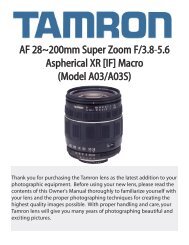
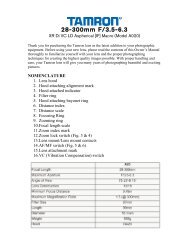

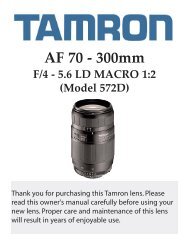
![SP AF17-50mm F/2.8 XR Di LD Aspherical [IF] - Tamron](https://img.yumpu.com/27036204/1/190x245/sp-af17-50mm-f-28-xr-di-ld-aspherical-if-tamron.jpg?quality=85)
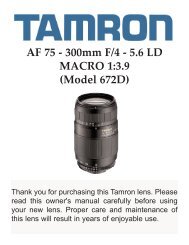
![AF 18~250 mm F/3.5-6.3 Di-II LD Aspherical [IF] - Tamron](https://img.yumpu.com/27036201/1/190x245/af-18250-mm-f-35-63-di-ii-ld-aspherical-if-tamron.jpg?quality=85)
![AF28-300mm F/3.5-6.3 XR Di LD Aspherical [IF] Macro ... - Tamron](https://img.yumpu.com/27036194/1/190x245/af28-300mm-f-35-63-xr-di-ld-aspherical-if-macro-tamron.jpg?quality=85)

![SP AF 14mm F/2.8 Aspherical [IF] (Model 69E) - Tamron](https://img.yumpu.com/27036192/1/190x245/sp-af-14mm-f-28-aspherical-if-model-69e-tamron.jpg?quality=85)
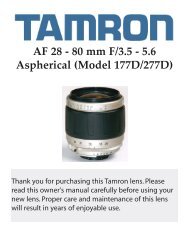
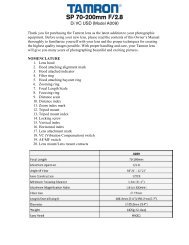
![SP AF 17~50 mm F/2.8 XR Di-II LD Aspherical [IF] (Model ... - Tamron](https://img.yumpu.com/27036181/1/190x245/sp-af-1750-mm-f-28-xr-di-ii-ld-aspherical-if-model-tamron.jpg?quality=85)